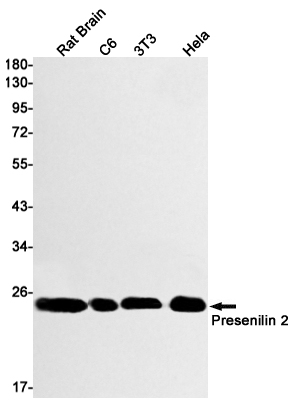
| WB | 咨询技术 | Human,Mouse,Rat |
| IF | 1/20 | Human,Mouse,Rat |
| IHC | 咨询技术 | Human,Mouse,Rat |
| ICC | 技术咨询 | Human,Mouse,Rat |
| FCM | 咨询技术 | Human,Mouse,Rat |
| Elisa | 咨询技术 | Human,Mouse,Rat |
| Aliases | AD3LP; AD5; E5-1; STM-2 |
| Entrez GeneID | 5664 |
| WB Predicted band size | Calculated MW: 50 kDa; Observed MW: 23 kDa |
| Host/Isotype | Rabbit IgG |
| Antibody Type | Primary antibody |
| Storage | Store at 4°C short term. Aliquot and store at -20°C long term. Avoid freeze/thaw cycles. |
| Species Reactivity | Human,Mouse,Rat |
| Immunogen | A synthetic peptide of human Presenilin 2 |
| Formulation | Purified antibody in TBS with 0.05% sodium azide,0.05%BSA and 50% glycerol. |
+ +
以下是3篇关于Presenilin 2(PSEN2)抗体的参考文献及其摘要概括:
---
1. **文献名称**: *Cloning of a gene bearing missense mutations in early-onset familial Alzheimer's disease*
**作者**: Sherrington, R., et al. (1995)
**摘要**: 该研究首次克隆了PSEN2基因,并发现其突变与家族性阿尔茨海默病相关。通过特异性抗体检测,证实PSEN2蛋白在脑组织中表达,且突变体导致β-淀粉样蛋白(Aβ42)生成增加。
2. **文献名称**: *Mutant presenilin 2 transgenic mice develop massive amyloid deposits without neuronal loss*
**作者**: Lah, J.J., et al. (2001)
**摘要**: 研究利用PSEN2抗体在转基因小鼠模型中检测突变体蛋白表达,发现突变PSEN2显著促进脑内淀粉样斑块沉积,但未直接导致神经元死亡,提示其病理机制的复杂性。
3. **文献名称**: *Gamma-secretase is a membrane protein complex composed of presenilin, nicastrin, Aph-1. and Pen-2*
**作者**: Kimberly, W.T., et al. (2003)
**摘要**: 通过免疫共沉淀和PSEN2抗体验证,研究证实PSEN2是γ-分泌酶复合体的核心组分,直接参与淀粉样前体蛋白(APP)的切割及Aβ生成调控。
---
如需更多文献,可补充说明具体研究方向(如抗体应用场景或疾病模型)。
Presenilin 2 (PSEN2) is a multi-pass transmembrane protein primarily located in the endoplasmic reticulum and Golgi apparatus. It serves as a catalytic subunit of the γ-secretase complex, which cleaves type I membrane proteins, including amyloid precursor protein (APP). PSEN2-mediated cleavage of APP generates β-amyloid peptides, particularly Aβ42. whose aggregation into plaques is a hallmark of Alzheimer’s disease (AD). Mutations in the PSEN2 gene are linked to early-onset familial Alzheimer’s disease (FAD), making it a critical target in neurodegenerative research.
Antibodies targeting PSEN2 are essential tools for studying its expression, localization, and function in both physiological and pathological contexts. These antibodies are commonly used in techniques like Western blotting, immunohistochemistry, and immunofluorescence to detect PSEN2 in cell lines, brain tissues, or animal models. They help elucidate PSEN2’s role in γ-secretase activity, APP processing, and interactions with other proteins involved in AD pathogenesis. Some antibodies specifically recognize epitopes in PSEN2’s N-terminal, C-terminal, or loop domains, enabling researchers to investigate structural or functional alterations caused by mutations. Monoclonal antibodies offer high specificity, while polyclonal antibodies may detect broader conformational variants. Validation of PSEN2 antibodies often involves knockout cell lines or siRNA-mediated silencing to confirm target specificity. Given PSEN2’s overlapping functions with Presenilin 1 (PSEN1), selective antibodies are crucial to distinguish their distinct contributions to AD mechanisms. These reagents also support drug discovery efforts aiming to modulate γ-secretase activity or reduce toxic Aβ production.
×